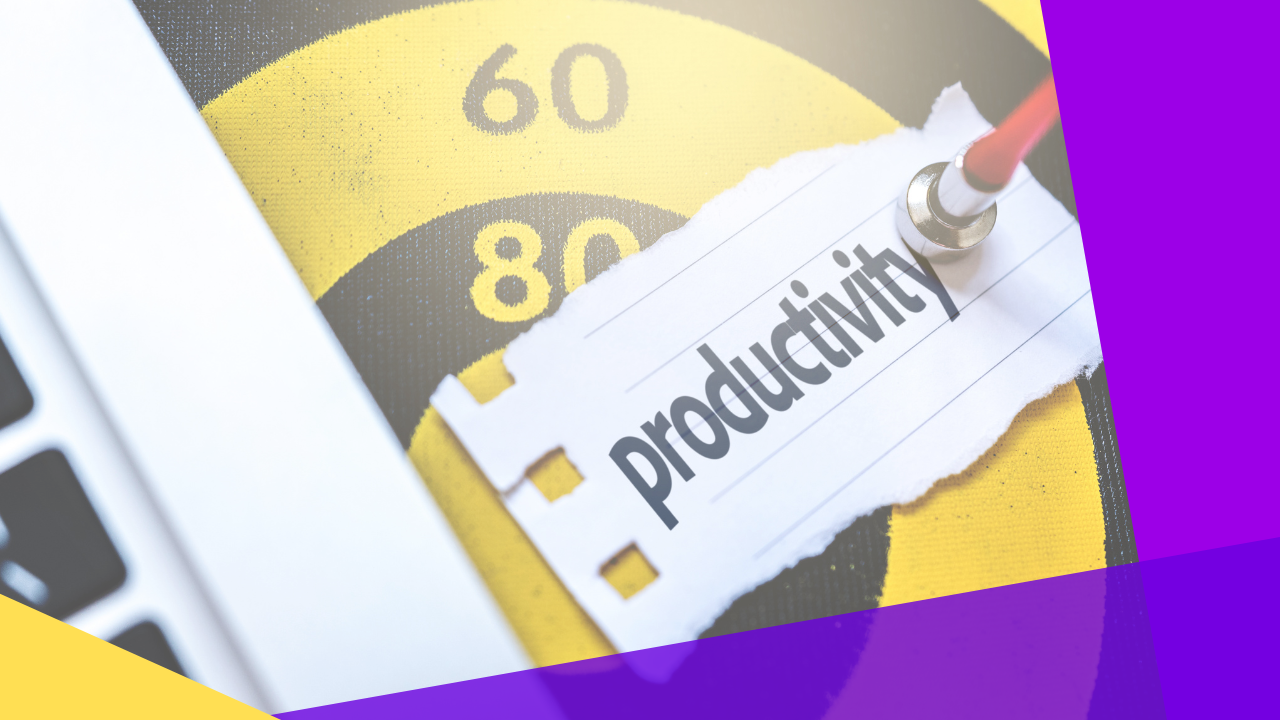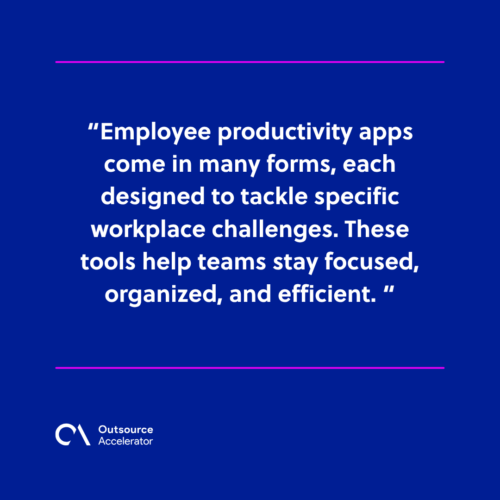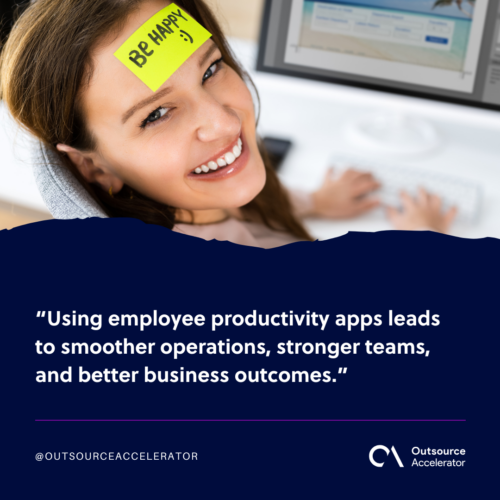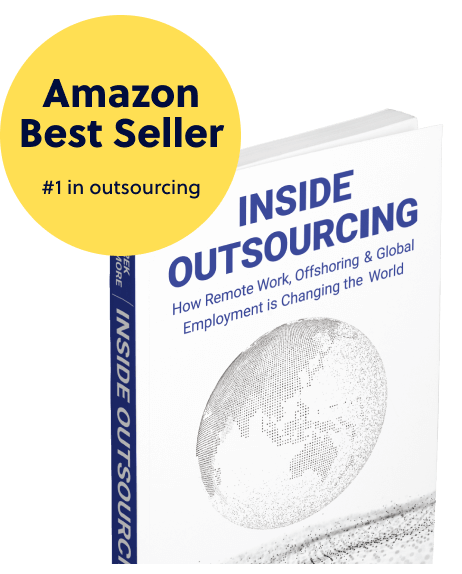15 smartest and most advanced employee productivity apps

List of employee productivity apps
- Hubstaff
- Toggl Track
- Pomodor
- Microsoft Outlook
- Loom
- Fireflies
- Reclaim
- Calendly
- Todoist
- Zapier
- Asana
- Teamwork
- Trello
- Zoho Projects
- Slack
Keeping teams productive has become increasingly challenging, especially with the rise of remote work. From missed deadlines to scattered communication, many teams struggle to stay aligned and focused. It’s easy for important tasks to slip through the cracks when employees work across different time zones or juggle multiple platforms. For example, a remote marketing team may spend more time searching for files or updating spreadsheets than actually executing campaigns. Fortunately, today’s technology offers smart solutions. Advanced employee productivity apps help teams collaborate, manage time, and stay organized, no matter where they are. In this article, we will highlight 15 of the smartest and most advanced employee productivity apps that support better teamwork, streamline workflows, and drive real results. Whether you’re leading a startup or managing a global team, these tools can transform the way your team works.
5 Types of employee productivity apps
Employee productivity apps come in many forms, each designed to tackle specific workplace challenges. These tools help teams stay focused, organized, and efficient.

Take note of the five common types of productivity apps every business should consider:
1. Project management
These types of apps help teams plan, assign, and track tasks. These tools give managers visibility into project progress and help teams stay aligned on priorities and deadlines. Project management apps are essential for maintaining structured workflows and clear goals.
2. Time tracking
These tools enable teams to track the hours spent on specific tasks. They help businesses monitor billable time, evaluate performance, and pinpoint distractions. These apps support accurate reporting and more productive work habits.
3. Communication and collaboration
Communication apps simplify how teams connect and share ideas. Whether through chat, video calls, or shared documents, these platforms support real-time collaboration and faster decision-making, especially valuable for remote teams.
4. Note-taking and organization
Note-taking apps help individuals organize information, capture ideas, and streamline daily planning. They’re perfect for managing both personal and team-related tasks in one place, improving clarity and focus.
5. Employee monitoring
This kind of software provides insights into how employees spend their time. These apps help identify workflow bottlenecks and offer data to improve productivity without micromanaging. Using the right mix of employee productivity apps can significantly enhance workplace performance.
Significant benefits of employee productivity apps
Employee productivity apps offer more than just convenience; they give teams the structure and tools they need to perform at their best. These apps help businesses adapt to fast-paced work environments, improve workflow, and increase accountability:
1. Better time management
Productivity apps help employees track their time usage. With time-tracking tools, teams can identify distractions, focus on high-priority tasks, and improve daily work habits. This leads to fewer wasted hours and more efficient schedules.
2. Improved team collaboration
With built-in chat, video, and file-sharing features, employee productivity apps make it easier for teams to collaborate in real time. Whether working remotely or in the office, everyone stays connected and aligned on tasks and goals.
3. Centralized task management
Project management apps keep all tasks, deadlines, and updates in one place. This helps reduce confusion, avoids missed assignments, and makes it easier for managers to track progress and delegate work efficiently.
4. Increased accountability
When employees use apps that log activity or track task completion, it becomes easier to measure output. This transparency fosters a culture of accountability, enabling everyone to stay on track and contribute equally.
5. Streamlined workflows
Productivity apps automate repetitive tasks and streamline processes. Teams can work faster and with fewer manual steps, giving them more time for strategic work. Using employee productivity apps leads to smoother operations, stronger teams, and better business outcomes.

Top 15 employee productivity apps for progressive teams
Here we have 15 of the best employee productivity apps for your teams:
1. Hubstaff
Hubstaff is a time tracking and productivity app designed for both remote and on-site teams. It helps businesses monitor time spent on tasks, track activity levels, and manage project budgets. Hubstaff gives managers the tools to run efficient operations using the following features:
- Payroll automation
- Employee monitoring
- Project cost reports
It’s ideal for companies that need detailed visibility into how their teams work. Whether you’re tracking billable hours or improving workflow, Hubstaff simplifies performance monitoring and supports better time and resource management. Additionally, Hubstaff has kept a head of the curve in the conversation about AI, publishing its AI Productivity Shift report to help organizations better incorporate the technology into their workflows. Plus, according to their Lean Advantage report, AI saved 30 mins of time per day, producing an even more productive workforce.
2. Toggl Track
Toggl Track is a flexible and user-friendly time tracking app ideal for freelancers, small teams, and remote workers. You can start tracking with one click, no need to enter project or client details upfront. It includes a Pomodoro timer, custom reports, and powerful integrations through Zapier. Automate time tracking by connecting Toggl to calendars, spreadsheets, or CRM tools. The free plan offers strong functionality, while paid versions unlock advanced features. Toggl Track is perfect for users who want simple, accurate time tracking without a steep learning curve.
3. Pomodor
Pomodor is a customizable Pomodoro timer built for focused productivity. It lets users adjust work sessions, break lengths, and the number of intervals before a longer rest. The timer runs directly in your browser and displays remaining time in the browser tab title, so you can track it while working in other tabs. It also features Dark Mode for a distraction-free experience. Pomodor offers just enough functionality to support the Pomodoro Technique without the clutter, making it a smart choice for anyone looking to manage time more effectively.
4. Microsoft Outlook
Microsoft Outlook is a powerful email and calendar app that supports Gmail, Yahoo, iCloud, and other accounts. It helps users manage multiple inboxes, schedule meetings, and organize communication with features like Focused Inbox and @mentions. You can delay sending emails, set follow-up reminders, and create custom profiles for work or personal use. These features make Outlook more than just an email tool—it’s a full productivity platform. Available for free, Outlook is a reliable option for users who want professional-grade email tools in one integrated space.
5. Loom
Loom is a screen recording app designed for quick video communication. You can record your screen, webcam, or both, making it ideal for walkthroughs, presentations, and tutorials. Loom works across all major platforms and allows users to trim clips, generate transcriptions, and remove filler words with AI-powered features. Titles, summaries, and chapters are auto-generated for easy navigation. The platform makes sharing seamless, and videos can be viewed instantly through links. Loom helps teams explain ideas visually, saving time on long emails and repetitive explanations.
6. Fireflies
Fireflies is an AI meeting assistant that automatically records and transcribes meetings, making note-taking effortless. It identifies speakers, highlights key discussion points, and extracts action items and questions. Once the meeting ends, Fireflies organizes everything into searchable summaries. You can connect it to apps like Slack, Asana, or Trello to automate follow-ups and create tasks instantly. For busy professionals who miss details or multitask during meetings, Fireflies helps capture and track what matters. It streamlines meetings, saves time, and keeps everyone aligned without manual effort.
7. Reclaim
Reclaim.ai is a smart calendar assistant that schedules your tasks around meetings, deadlines, and personal time. It analyzes your workload and fills open slots with prioritized tasks, defending time blocks against unexpected meeting invites. You can sync it with tools like Google Tasks, Todoist, or Asana to automate task scheduling. Reclaim also reschedules recurring 1:1s if someone cancels, helping you keep important meetings on track. With built-in smart suggestions and flexible time blocking, Reclaim makes calendar management hands-free and efficient, especially for teams with packed schedules.
8. Calendly
Calendly is a reliable meeting scheduler that eliminates back-and-forth emails. Users can set availability, meeting types, and durations, then share booking links so invitees can pick a time that works. Once scheduled, Calendly sends confirmations and updates automatically. It integrates with tools like Zoom, Google Calendar, and Zapier to trigger workflows—like creating calendar events or sending follow-up emails. The free plan offers enough features for solo users, while premium plans support advanced scheduling. Calendly helps professionals save time and keep their calendar organized with zero manual input.
9. Todoist
Todoist is a task management app that strikes a balance between simplicity and power. It works across all major platforms and allows users to organize tasks by project, priority, and due date. You can add labels, set recurring deadlines, and collaborate with team members on shared tasks. Todoist integrates with calendars, email, and productivity tools to streamline your workflow. Its flexibility makes it ideal for personal task lists or full team projects. Whether you’re managing work goals or daily routines, Todoist helps turn ideas into action.
10. Zapier
Zapier is an automation platform that connects your favorite apps and moves data between them with custom workflows, called “Zaps.” Instead of doing repetitive tasks manually—like copying customer data or sending emails—you can automate them with a few clicks. For example, you can create a Zap to log new Shopify orders in Google Sheets and notify your team in Slack. Zapier supports thousands of apps, making it a go-to for businesses that want to improve efficiency and eliminate routine tasks without writing any code.
11. Asana
Asana is a flexible task management tool designed for individuals and teams to track everything from daily to-dos to large-scale projects. It offers multiple viewing options, including lists, timelines, and Kanban boards, to fit different work styles. You can assign tasks, set deadlines, and collaborate through comments and file attachments. Whether you work alone or in a team, Asana helps keep ideas organized and projects moving forward. Asana simplifies task tracking for any workflow. Its clear layout and collaboration tools make it a favorite for boosting productivity.
12. Teamwork
Teamwork is a project management platform tailored for small to midsize businesses needing an easy setup and intuitive interface. Team leads can organize deadlines, set milestones, and assign tasks, while team members update their progress in real time. Everyone gets access to what they need, which improves visibility and communication. Teamwork supports Gantt charts, time tracking, and file sharing to streamline project delivery. It’s built for teams that value structure and clarity. With Teamwork, managing multiple projects becomes less stressful and more collaborative from day one.
13. Trello
Trello makes task management visual and engaging using a Kanban-style board. You can create cards for each task, add details, assign team members, and set deadlines. As work progresses, move cards between columns like To-Do, Doing, and Done. Trello is easy to learn and customizable for personal use, team projects, or content planning. Trello has features like checklists, labels, and integrations. It adapts to almost any workflow, and it is perfect for users who prefer a drag-and-drop style of organizing tasks. Trello brings simplicity and structure together to keep your projects on track.
14. Zoho Projects
Zoho Projects is a cost-effective project management app built for teams that need powerful features without the premium price tag. It offers task lists, time tracking, Gantt charts, and team collaboration tools—all accessible from a clean, modern interface. You can also integrate it with other Zoho apps and popular third-party tools. Zoho Projects includes a free version with solid functionality, making it accessible for startups or small teams. It’s a smart choice for businesses looking to manage growth efficiently.
15. Slack
Slack is a team communication app that makes it easy to connect through messaging, calls, and shared channels. Users can create topic-based channels, send direct messages, or collaborate privately with small groups. It supports file sharing, app integrations, and even bots to automate workflows. Slack works well for remote and hybrid teams that need real-time or asynchronous communication. It’s more dynamic than email and helps build stronger team relationships. Overall, employee productivity apps significantly help teams work better, stay organized, and communicate more effectively, especially in today’s fast-paced and remote-first environments. Choosing the right tools for your team’s unique needs means you can streamline daily operations and unlock greater performance across your organization!







 Independent
Independent




